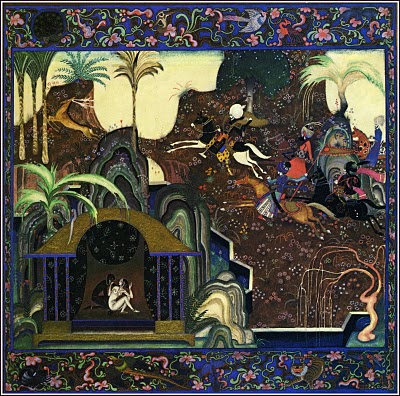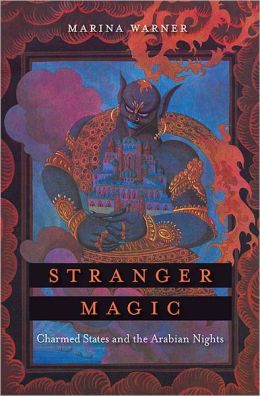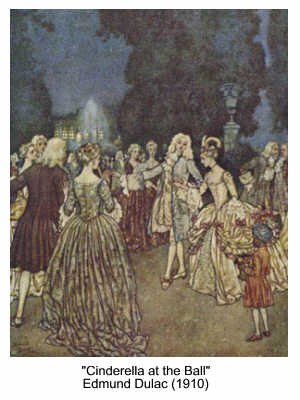Hipster Disney princesses (and Iago)
Monday, January 28, 2013
Cory-Ellen Nadel's "Scheherezade's Saving Grace"
The poem "Scheherezade's Saving Grace" by Cory-Ellen Nadel is told from Scheherezade's perspective, but really applies to fairy tales in general (and also references specific non-Arabian Nights tales, such as Little Red Riding Hood) and a lot of the issues of appropriateness for children, and the nature of tales and their audience.
She starts with,
"Some of my stories are pleasant
tales you can tell to children
publish in hardcovers with bright pictures in primary colors,
my photo smiling on the jacket"
Which is the most common idea of fairy tale collections people have today. But she also mentions "pleasant tales you should save for adults", "not pleasant tales," and ends with,
"Some of them are downright nasty tales
and hearing them you retch, but you know
(you always knew)
that they are the truest of all my stories
and that is why they leave you
lying awake and tearful,
staring into darksome night and remembering
my face, terrible as god
as I told them
to save myself."
She starts with,
"Some of my stories are pleasant
tales you can tell to children
publish in hardcovers with bright pictures in primary colors,
my photo smiling on the jacket"
Which is the most common idea of fairy tale collections people have today. But she also mentions "pleasant tales you should save for adults", "not pleasant tales," and ends with,
"Some of them are downright nasty tales
and hearing them you retch, but you know
(you always knew)
that they are the truest of all my stories
and that is why they leave you
lying awake and tearful,
staring into darksome night and remembering
my face, terrible as god
as I told them
to save myself."
It's a pretty short poem, click through to read the whole thing!
Wednesday, January 23, 2013
Scheherezade's role as Storyteller
In the frame story of the Arabian Nights, Scheherezade must attempt to save her life by storytelling to end the cycle of Shahriyar's killing a new wife every night. Though Shahriyar's character is similar to Bluebeard, the serial killing husband, Bluebeard has no given reason for his killing spree. Yet Shahriyar has a history which makes him a little more sympathetic. He had found his Sultana and her maids cavorting with slaves and decided to take out his vengeance on the female race. Not only that, but his brother Shahzenan had also caught his wife cheating with a slave.
Shahriyar does have reason, then, to be doubtful of the fidelity of women, just as anyone who has been betrayed will find it hard to trust again (although his actions are obviously not justified). Therefore, when Sheherezade is telling her stories, she is not only adding one more day to her own life, but attempting to "clear this anger and remove the rationale for the men's hatred."
The stories contain all sorts of female characters, as a well-rounded collection of tales should (i.e., not all passive women who sit and wait to be rescued as is the traditional stereotype; but not also only sword-weilding athletic warriors as is becoming the only way to portray females in our very gender sensitive society). Some of the characters even appear to enforce negative female stereotypes.
Yet throughout the Nights there is a message of vindication for the female sex. First of all is Scheherezade herself. Not only was she bold enough to request that she be made the Sultan's new bride, but despite her father the Vizier's warning her against it, she holds her own and insists. Unheard of for the culture from which these stories came! A woman defies her father's will and goes on to redeem a Sultan, save her own life and countless others who would have come after her.
Scheherezade tells tales from the female side of view as well-those featuring "maltreated wives, subjugated daughters, faithful female lovers, clever and courageous slave girls, courageous loving mothers, intelligent teachers, loyal sisters and devotes peris or fairies in an increasingly shining procession of women: refracting the virtues of the storyteller herself and her audience-but not so undilutedly or obviously that her purpose shows too much." I think that last part is key, because so many fairy tales have become most famous in versions that are overly preachy and can get tiresome.
In the end Scheherezade's goal is to heal Shahriyar and show him a world of possibilities outside of those in his negative experiences. Earlier tales in the collection are more cynical, but they progress "towards a politics of love and justice that opens the cruel Sultan's eyes to another vision of humanity and to his responsibilities as a ruler."
I believe that the stories and entertainment with which we feed ourselves can and do shape who we are; we can be inspired or jaded, our eyes opened to new ways of thinking and experiences beyond our own. Marina Warner reminds us that the Nights are essentially stories about the power of stories-the suspense they create are literally Scheherezade's only hope for survival. The same stories that served to entertain a murderous Sultan have fascinated the world for hundreds of years and have influenced culture in ways we don't even realize.
All information and quotes were taken from the introduction to Marina Warner's Stranger Magic: Charmed States and the Arabian Nights. 400+ pages on the Arabian Nights, a realm of the fairy tale world it's very difficult to find much information on! Expect more posts from this book throughout the year as I find snatches of time to read...
Illustrations of Bluebeard and Arabian Nights by Kay Nielsen (cover art for the book is by Errol Le Cain)
Shahriyar does have reason, then, to be doubtful of the fidelity of women, just as anyone who has been betrayed will find it hard to trust again (although his actions are obviously not justified). Therefore, when Sheherezade is telling her stories, she is not only adding one more day to her own life, but attempting to "clear this anger and remove the rationale for the men's hatred."
The stories contain all sorts of female characters, as a well-rounded collection of tales should (i.e., not all passive women who sit and wait to be rescued as is the traditional stereotype; but not also only sword-weilding athletic warriors as is becoming the only way to portray females in our very gender sensitive society). Some of the characters even appear to enforce negative female stereotypes.
Yet throughout the Nights there is a message of vindication for the female sex. First of all is Scheherezade herself. Not only was she bold enough to request that she be made the Sultan's new bride, but despite her father the Vizier's warning her against it, she holds her own and insists. Unheard of for the culture from which these stories came! A woman defies her father's will and goes on to redeem a Sultan, save her own life and countless others who would have come after her.
Scheherezade tells tales from the female side of view as well-those featuring "maltreated wives, subjugated daughters, faithful female lovers, clever and courageous slave girls, courageous loving mothers, intelligent teachers, loyal sisters and devotes peris or fairies in an increasingly shining procession of women: refracting the virtues of the storyteller herself and her audience-but not so undilutedly or obviously that her purpose shows too much." I think that last part is key, because so many fairy tales have become most famous in versions that are overly preachy and can get tiresome.
In the end Scheherezade's goal is to heal Shahriyar and show him a world of possibilities outside of those in his negative experiences. Earlier tales in the collection are more cynical, but they progress "towards a politics of love and justice that opens the cruel Sultan's eyes to another vision of humanity and to his responsibilities as a ruler."
I believe that the stories and entertainment with which we feed ourselves can and do shape who we are; we can be inspired or jaded, our eyes opened to new ways of thinking and experiences beyond our own. Marina Warner reminds us that the Nights are essentially stories about the power of stories-the suspense they create are literally Scheherezade's only hope for survival. The same stories that served to entertain a murderous Sultan have fascinated the world for hundreds of years and have influenced culture in ways we don't even realize.
All information and quotes were taken from the introduction to Marina Warner's Stranger Magic: Charmed States and the Arabian Nights. 400+ pages on the Arabian Nights, a realm of the fairy tale world it's very difficult to find much information on! Expect more posts from this book throughout the year as I find snatches of time to read...
Illustrations of Bluebeard and Arabian Nights by Kay Nielsen (cover art for the book is by Errol Le Cain)
Sunday, January 20, 2013
Cinderella and midnight
Though the plot element that Cinderella must return before midnight is one that has become popularized due to Perrault's version and is not necessarily integral to the tale (see full blog post from July), there may be significance and symbolism in that image. I learned this interesting tidbit about masquerade balls from (of all things...) Timothy Keller's book, The Meaning of Marriage:
"There’s a passage in Søren Kierkegaard’s work where he likens all of us to people at a costume ball. “Do you not know that there comes a midnight hour when every one has to throw off his mask?” At the time, the custom was to keep your mask on for the first part of festivities. During that time, you danced, ate, and talked with the other guests, but no one knew who anyone else was. But then at midnight all masks had to be stripped off and everyone’s true identity was revealed. In some ways, the Cinderella story is an extension of this theme, that an hour comes in which all the layers of glitter are taken away and the real, unvarnished you stands there, unfiltered for all to see."
(emphasis mine)
Though Cinderella isn't often portrayed as going to a masquerade ball, I think it's a poignant enough image to apply to understanding the tale and how it would have been interpreted in other contexts. Midnight is clearly the time of Cinderella revealing her hidden identity as a servant, but even there there's room to go even deeper, because her true identity is really her father's daughter, and rightful co-heir of his estate. So there's lots of layers and complexity (and a good reminder for us not to be hasty in assuming things about other people as well!).
Surlalune's annotations include this: "Midnight is the most common time given as a deadline in the Cinderella tale. Since midnight marks the beginning of a new day and the end of power in the old day, such a deadline is also reasonable. Midnight also marks the beginning of the witching hour." By the way, I've enjoyed reading about early Cinderellas over on the Surlalune blog recently, I hope you all have too!
Errol le Cain
"There’s a passage in Søren Kierkegaard’s work where he likens all of us to people at a costume ball. “Do you not know that there comes a midnight hour when every one has to throw off his mask?” At the time, the custom was to keep your mask on for the first part of festivities. During that time, you danced, ate, and talked with the other guests, but no one knew who anyone else was. But then at midnight all masks had to be stripped off and everyone’s true identity was revealed. In some ways, the Cinderella story is an extension of this theme, that an hour comes in which all the layers of glitter are taken away and the real, unvarnished you stands there, unfiltered for all to see."
(emphasis mine)
Though Cinderella isn't often portrayed as going to a masquerade ball, I think it's a poignant enough image to apply to understanding the tale and how it would have been interpreted in other contexts. Midnight is clearly the time of Cinderella revealing her hidden identity as a servant, but even there there's room to go even deeper, because her true identity is really her father's daughter, and rightful co-heir of his estate. So there's lots of layers and complexity (and a good reminder for us not to be hasty in assuming things about other people as well!).
Surlalune's annotations include this: "Midnight is the most common time given as a deadline in the Cinderella tale. Since midnight marks the beginning of a new day and the end of power in the old day, such a deadline is also reasonable. Midnight also marks the beginning of the witching hour." By the way, I've enjoyed reading about early Cinderellas over on the Surlalune blog recently, I hope you all have too!
Tuesday, January 15, 2013
Thoughts on Beasts, Mermaids, and Otherness
I was thinking after posting the Mermaid song about how I don't know any mermaid stories that aren't love stories. Even siren tales, though their intentions aren't romantic, are about the dangers of seductive women and men who cannot resist them. I definitely think that mermaid stories are a way of reflecting on the Otherness of women-this strange species that is different than men, beautiful and in some ways may seem supernatural; at times they have been interpreted as cruel and vindictive (sirens) and at other times as helpless victims (Anderson's Little Mermaid), just as women themselves have used their wiles for selfish temptations, or have become powerless and passive in different circumstances. Yet they can also represented as unattainable and ultimately in charge of their own fate in the selkie tales of women who wait to reclaim their sealskins to return to their own lives, and cannot be contstrained by the human men who attempt to capture them.
This reminded me of Beauty and the Beast. I think it's a pretty agreed upon fact that the Animal Bridegroom cycle of tales, though specific versions may have had more specific purposes, can be seen as women and their perception of the Otherness of males (see Jerry Griswold's opinion). Which is not to say that all women think all men are ugly by any means, but especially to very young girls being married off to stranger, often older men, they would have been seen as potentially dangerous and terrifying, as well as strange and mystifying. Modern women tend to be attracted to the idea of the wild and dangerous Beast, and the thought of a forbidden romance.
One of my big concerns has been wondering about the lack of female bride stories in our culture-those that exist in folklore have been largely lost. I had wondered before if this was a reflection of the shallowness of our culture-neither men or women want to either contemplate the idea of an ugly woman. This may still be true to some extent, and I think females have in the past and still do have more pressure to find their identity in appearances than men in general. But maybe it's not a fair comparison-when men contemplate the Otherness of women, they turn to mermaid tales, or selkies or sirens-whereas women contemplating the Otherness of men will turn to Beastly grooms.
Just a thought I had. Would welcome other opinions or discussion in the comments.
Maxwell Armfield
Warwick Goble
Just a thought I had. Would welcome other opinions or discussion in the comments.
Saturday, January 12, 2013
Train-Mermaid
The song "Mermaid" by the band Train. Partial lyrics are below:
"Can't swim so I took a boat,
To an island so remote
Only Johnny Depp has ever been to it before
Stayed there till the air was clear
I was bored and out of tears,
Then I saw you washed up on the shore
I offered you my coat, thank goddess love can float
Crazy how that shipwreck met my ship was comin' in
We talked till the sun went down
Love on the Puget Sound
My treasure map was on your skin
Beauty in the water, angel on the beach
Ocean's daughter,
I thought love was out of reach 'til I got her,
had I known it could come true I would have wished in '92, for a mermaid just like you
Whoa, just like you, whoa
Sharks green with envy they wonder what you see in me
Funny but sometimes can't help but wonder that as well
Now life is a holiday, making up for the years I paid
The way to this heavenly bay... it went through hell"
Wednesday, January 9, 2013
Belle by Disneybound
My sister sent me the link to this pinterest board, which is full of Disney Belle-inspired outifts! When a website's tagline is "where fashion geeks and Disney nerds collide", in the words of my friend, "you should love this site!!" I have the urge to wear blue or yellow tomorrow...it's a little disturbing how easily I can recreate similar outfits to these with things I already own...
Tuesday, January 8, 2013
Artist feature: Jennie Harbour
Very little is known about artist Jennie Harbour (1893-1959) -she doesn't even have her own wikipedia page! She illustrated many fairy tales in the Art Deco era, and if you need a little Art 101 refresher like I did, according to wikipedia: "It is an eclectic style that combines traditional craft motifs with Machine Age imagery and materials. The style is often characterized by rich colors, bold geometric shapes and lavish ornamentation."
Cinderella:
Cinderella:
Little Red Riding Hood:
Sometimes simple black and white can be more striking than lush color. I love the little wolf lurking in the corner of this one-
Sleeping Beauty:
Hansel and Gretel:
More of Jennie Harbour's illustrations can be viewed over on Surlalune.
Friday, January 4, 2013
Bluebeards and Blackbeard
Many well-known fairy tale figures become universally known and can be used as a reference to another story that contains the same basic story element: a rise in status or "rags-to-riches" story can be a Cinderella story, anyone marrying outisde of their social or perceived physical station is a Beauty or a Beast, etc. Darker elements can be labelled with fairy tale names as well-male predators are often compared to the wolf in Little Red Riding Hood, and serial killers sometimes bear the title Bluebeard.
Blackbeard the pirate, or Edward Teach, has often been confused with Bluebeard-often unintentionally, but sometimes intentionally by writers who link the the actual pirate with the character. In a time when most men were clean-shaven, both men terrified listeners with their odd beards-Blackbeard's grew all over his face, and he would even light slow-burning fuse cords under his hat so that his beard would appear to be burning and smoke would rise out of it.
The two bearded men were contemporaries-Blackbeard terrorized the seas in the late 17th/early 18th centuries, and Charles Perrault's "Bluebeard" appeared in France in 1697. Blackbeard sources pretty unanimously agree that he had fourteen wives. Although he did not likely murder them like Bluebeard, but married polygamously, his treatment of his wives was cruel-his last wife, a 16-year-old planter's daughter, he forced to prostitute herself to several of his companions while he watched.
Visitors to the U.S. Virgin Islands can visit either Blackbeard's Castle, said to have been used by Blackbeard and now a U.S. National Historic Landmark:
Blackbeard the pirate, or Edward Teach, has often been confused with Bluebeard-often unintentionally, but sometimes intentionally by writers who link the the actual pirate with the character. In a time when most men were clean-shaven, both men terrified listeners with their odd beards-Blackbeard's grew all over his face, and he would even light slow-burning fuse cords under his hat so that his beard would appear to be burning and smoke would rise out of it.
The two bearded men were contemporaries-Blackbeard terrorized the seas in the late 17th/early 18th centuries, and Charles Perrault's "Bluebeard" appeared in France in 1697. Blackbeard sources pretty unanimously agree that he had fourteen wives. Although he did not likely murder them like Bluebeard, but married polygamously, his treatment of his wives was cruel-his last wife, a 16-year-old planter's daughter, he forced to prostitute herself to several of his companions while he watched.
Visitors to the U.S. Virgin Islands can visit either Blackbeard's Castle, said to have been used by Blackbeard and now a U.S. National Historic Landmark:
Or, on the other side of town, Bluebeard's Castle, a resort. It was supposedly built by Bluebeard for his love, Mericedita, who cheated on him, so he left her.
Aside from the pirate, other serial killers have been referred to in the press as Bluebeards, such as H.H. Holmes, who married bigamously and was convicted of killing 27 men, women, and children. His "murder castle," specifically designed with "labyrinthine corridors, chutes to the cellar, a vault disguised as a room, trapdoors, and dead ends" was referred to as "Bluebeard's Chamber of Horror." Henri Landru, Johann Otto Hoch, George Joseph Smith, and Ed Gein are other murderers with similar enough details to merit comparison.
Bluebeards are not limited to males-female serial kills of husbands (mostly for monetary gain) are also referred to as Lady Bluebeards, such as Belle Gunness and Lyda Trueblood.
Information was taken from the book Bluebeard: a Reader's Guide to the English Tradition by Casie E. Hermansson. This book was one of my Christmas presents...nothing like a nice morbid post to start off the new year, right?
Subscribe to:
Comments (Atom)































